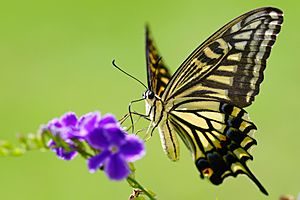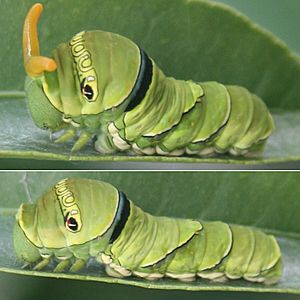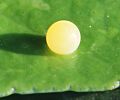Asian swallowtail facts for kids
Quick facts for kids Asian swallowtail |
|
|---|---|
 |
|
| Scientific classification |
The Papilio xuthus, also known as the Asian swallowtail or Chinese yellow swallowtail, is a beautiful yellow butterfly. It is a medium to large sized swallowtail butterfly. You can find it across many parts of Asia. This includes places like northern Myanmar, southern China, Taiwan, the Korean Peninsula, and Japan. It also lives in Siberia and the Hawaiian Islands. In 2014, it was even seen in Arunachal Pradesh, India.
This butterfly mates many times in its life. This helps create more different types of genes in its young. Many animals like tree crickets, ants, and wasps hunt it. The Asian swallowtail uses its amazing color vision to find its favorite plants. These plants belong to the Rutaceae family.
The Asian swallowtail is a very common butterfly. It is not in danger of disappearing. You can often spot it in cities, suburbs, woods, and orange farms. These butterflies usually fly from May to August.
Male butterflies use both touch and sight to find mates. Female butterflies often mate with more than one partner. After mating, females look for the best places to lay their eggs. They choose spots based on how good the habitat is and what food is available.
Contents
About the Asian Swallowtail
What is its scientific name?
The Papilio xuthus is part of the Papilio group of butterflies. Other butterflies in this group include the Papilio appalachiensis and the Papilio glaucus. It belongs to the family called Papilionidae. Its order is Lepidoptera, which includes all butterflies and moths.
This butterfly first arrived in Hawaii in 1971. It came from Japan or Guam. P. xuthus can fly very long distances. It sometimes travels over 200 kilometers during different seasons. There are two types, or subspecies, of P. xuthus. They are called Papilio xuthus koxingus and Papilio xuthus neoxuthus.
What does it look like?
The Asian swallowtail is a medium-sized butterfly. It is yellow and has noticeable tails on its wings. Its wingspan is about 45 to 55 millimeters wide. It usually has black patterns on a bright yellow background.
Male and female butterflies have slightly different wing colors. Females have wider black bands on the inner part of their hindwings. The black bands on the hindwings have shiny blue and orange scales between them. The forewings also have black stripes of different thicknesses.
When they are young caterpillars, they look like bird droppings. This helps them hide from predators. They have a white and brown spot on their head. As they grow older, caterpillars turn light green with brown spots.
How do their wings get their color?
P. xuthus butterflies have special eyes. These eyes can see many different colors of light. This helps them recognize other butterflies of their own kind. Their unique colors and patterns make them stand out.
Butterfly wing colors come from tiny "scales." The Asian swallowtail has yellow, orange, black, and blue scales. These scales absorb and reflect light in different ways. Yellow scales absorb UV and violet light. Orange scales absorb lower visible light. Black scales absorb most visible light. Blue scales absorb very little light.
The colors come from special molecules called pigments. Yellow and orange scales have a pigment called papiliochrome II. Black scales have melanin. Blue scales are different. They don't have a pigment. Instead, their blue color comes from how light bounces off their scales. This is called an optical phenomenon.
The butterflies use these wing colors and patterns to find other butterflies of the same species. Males are attracted to females just by seeing their colors. They can find other butterflies of their kind even if they don't smell them.
Finding a Mate and Laying Eggs
How do they find mates?
During mating season, male Asian swallowtails fly through tree leaves. They are looking for a female. If a male sees a female resting with her wings open, he will approach her. He touches her wing tips with his front legs. Males are especially drawn to yellow patches on female wings that are close together.
Most female Asian swallowtail butterflies mate more than once. This is common for many swallowtail butterflies. Mating multiple times helps females have more genetically diverse offspring. It also allows them to lay more eggs, sometimes up to thirty.
Where do they lay eggs?
Female butterflies spread out when they are ready to lay eggs. They choose where to lay their eggs carefully. They look at how good the area is and how many other adult butterflies are there. They also check for young leaves, how much sun the spot gets, and the height of the plant. Females prefer sunnier areas.
Dangers and Survival
Who hunts them?
Some insects, like the grasshopper Oeanthus longicauda, can remove Asian swallowtail larvae from their eggs. When the caterpillars are very young, their main predators are ants, especially Lasius niger. Spiders and other bugs also hunt them.
Asian swallowtail caterpillars can also be attacked by wasps. Wasps like Trogus mactator and Pteromarus puparum lay their eggs inside the caterpillars. These wasps eventually kill the caterpillars after they turn into pupae. Sometimes, wasps emerge from the pupa days after the butterfly was supposed to come out.
How does the environment affect them?
Besides predators, diseases can also affect caterpillars. These diseases seem to be linked to how long the rainy season lasts. Long periods of rain in autumn can cause infected larvae to rot.
Finding Food
Asian swallowtail butterflies have amazing color vision. This means they can tell colors apart, no matter how bright they are. They also have "color constancy." This allows them to recognize a color even if the background light changes. For example, they can still see a flower's true color whether it's in the sun or shade. This skill is very important for finding food.
What do they eat?
The larvae (caterpillars) of this butterfly eat plants from the Rutaceae family. Some of their favorite food plants include:
- Phellodendron amurense
- Poncirus trifoliata
- Different Zanthoxylum species, like the Japanese pepper tree (Z. piperitum)
- Cultivated Citrus species, such as mandarin orange and yuzu
- Euodia ruaecarpa
- Ruta graveolens (rue)
- "Bauhinia" species, like the Hong Kong Orchid Tree
Life Cycle and Population
The Asian swallowtail butterfly lives in many places. However, its population usually stays at a steady, low level. There are usually four to five generations of butterflies each year. The first generation of adults appears from mid-April to early May. The second generation emerges in mid-June.
Female P. xuthus lay single eggs on the leaves of host plants. Once hatched, the larvae (caterpillars) eat plants like Poncirus trifoliata, Zanthoxylum ailanthoides, and various citrus plants. The caterpillar stage lasts about three to five weeks. The pupal stage, when it's in its chrysalis, lasts about two weeks.
Studies show that the Asian swallowtail population stays surprisingly stable. This is partly because of tiny wasps called parasitoids. These wasps, like Trichogramma and Pteromalus puparum, lay their eggs in the butterfly eggs or pupae. The wasps have shorter life spans than the butterflies. So, if the butterfly population grows, the wasp population can grow quickly too. This helps keep both the butterflies and the wasps in balance. Also, butterflies moving between different groups helps keep the whole population stable.
Gallery
See also
 In Spanish: Papilio xuthus para niños
In Spanish: Papilio xuthus para niños






